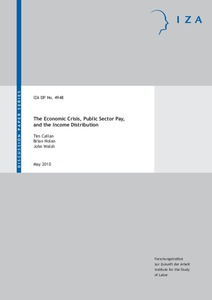The economic crisis, public sector pay, and the income distribution
"An important aspect of the impact of the economic crisis is how pay in the public sector responds – in the face not only of the evolution of pay in the private sector, but also extreme pressure on public spending (of which pay is a very large proportion) as fiscal deficits soar. What are the e...
| Main Authors: | , , |
|---|---|
| Institution: | ETUI-European Trade Union Institute |
| Format: | TEXT |
| Language: | English |
| Published: |
Bonn
2010
IZA |
| Subjects: | |
| Online Access: | https://www.labourline.org/KENTIKA-19184759124919029319-The-economic-crisis,-public-se.htm |
| Summary: | "An important aspect of the impact of the economic crisis is how pay in the public sector responds – in the face not only of the evolution of pay in the private sector, but also extreme pressure on public spending (of which pay is a very large proportion) as fiscal deficits soar. What are the effects on the income distribution of cutting public sector pay rates or alternative strategies to reduce the public sector pay bill, and how does these vary depending on the evolution of pay in the private sector? This paper investigates these issues using data and a tax-benefit simulation for Ireland, a country which faces a particularly severe fiscal crisis and where innovative measures have already been implemented to claw back pay from public sector workers in the guise of a "pensions levy", followed most recently by a significant cut in nominal pay rates. The SWITCH tax-benefit model first allows the distributional effects of these measures, which achieved a substantial reduction in the net public sector pay bill, to be teased out. The overall impact on the income distribution, set against alternative scenarios for pay in the private sector, is assessed. This provides empirical evidence relevant to policy choices in relation to a key aspect of household income over which governments have direct influence, while at the same time illustrating methodologically how a tax-benefit model can serve as the base for such investigation. " |
|---|---|
| Physical Description: | 1 v. Digital |

